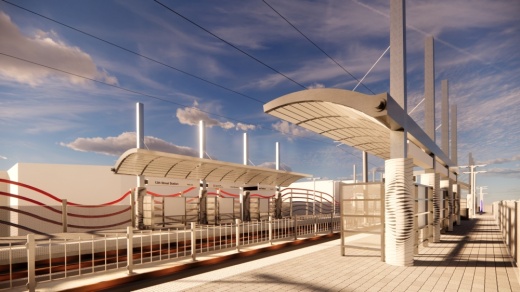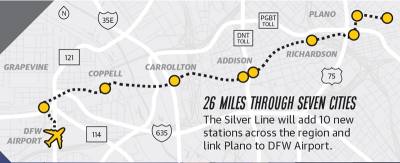The Silver Line is a $1.89 billion commuter rail line being built by DART that will connect Plano travelers to the Dallas Fort Worth International Airport with an estimated travel time of 60 minutes or less, according to figures released by the transit agency.
DART is funded by a $0.01 sales tax from the 13 Dallas-area cities that make up its service area, including Plano. The Silver Line is mostly paid for through a $908 million federal loan from the U.S. Department of Transportation and some capital financing programs by DART.
The project was originally planned to be complete this year, but DART announced last summer it would be delayed until late 2024. Complications from the COVID-19 pandemic and issues in acquiring land were cited as factors by DART.
“The biggest concern we had was [COVID-19],” DART spokesperson Gordon Shattles said. “It definitely slowed down our entire process.”
The line follows the route of the old Cotton Belt Railroad freight line and has been discussed since the 1990s, according to DART. The west end of the 26-mile line will end at DFW Airport Terminal B, and the east end will stop at the future site of the Shiloh Road Station in Plano.
However, DART and Plano officials said the line could expand farther in the future. The line will add 10 new stations with two in Plano and two in Richardson. In Plano, the Shiloh Road Station will be located at 1101 Shiloh Road, and the 12th Street Station will be located at 1180 12th St. Shattles said construction should begin in Plano on the 12th Street Station by the end of February and will start on the Shiloh Road Station later this year.
Added benefits
Peter Braster, Plano’s director of special projects, said the Silver Line and its two stations coming to Plano are positives for developers looking to build in those areas. Ferro, a high-end apartment development, is being built at 1005 11th St., adjacent to the future 12th Street Station. It is expected to open this summer. Eight townhomes are also in the early stages of development nearby on a lot off 10th Street and K Avenue.
The 12th Street Station is surrounded by a few vacant lots, a scrapyard and auto mechanic shops. The Shiloh Road Station will be directly flanked by two empty lots with industrial and storage facilities nearby.
Braster said the city has not laid out an official plan to develop around the stations but that the Silver Line has attracted development regardless.
“The marketplace took care of it for us,” Braster said. “Historically, [developers] get a little more rent when it’s within walking distance to a rail line.”Matt Enzler, a senior managing director with Trammell Crow Residential, an apartment development company, said the ability for residents to commute directly to the airport is a strong selling point for those looking to move into Plano or Richardson.“It is a pretty big pain to go from those northern suburbs to [DFW Airport],” Enzler said. “I think it is a pretty big deal that you [will be able to] take a straight shot.”Enzler said the Silver Line will attract more developers to Plano and Richardson. “It is just that much more desirable,” Enzler said. “It’s a really big deal to be a [transit-oriented development].”
While the Silver Line will help those commuting to DFW Airport, Braster said the line will have a number of additional benefits.
“Say you wanted to commute from east Plano or farther,” he said. “You could get off in Addison or transfer over to Carrollton and go down to the hospitals or [Dallas Love Field Airport].”
Braster believes the rail line will give Plano residents without personal transportation more commuting options. He listed possible jobs in the Dallas County Hospital District, Fort Worth and Addison as well as tech companies in Richardson and manufacturing facilities near the Shiloh Road Station as all being more accessible.
As North Texas began rapidly growing in population, Shattles said DART and transportation officials knew the project was needed.
“We were seeing growth from the center of downtown Dallas past even the farthest suburbs,” he said.
Staying mobile
The North Central Texas Council of Governments in its official long-term transportation plan stated the need for a “high-performance regional rail network linking communities throughout North Central Texas.”
The plan recommends spending over $30 billion to expand regional rail transit systems by 2045. According to the U.S. Census Bureau, Collin County’s population is just over 1 million residents. A 2017 study on the county’s website projects that number to double by 2040. Dan Lamers, a NCTCOG transportation planning manager, said the council has worked in partnership with DART to give commuters more options.
“Driving on congested freeways may not be right for everyone,” he said. “There is no way we can build enough roads.”
Lamers said developing more rail systems using old freight lines—as the Silver Line will—is a cost-effective way to add regional mobility.
“We are looking at all available railroads ... for potential use in the future,” he said.








